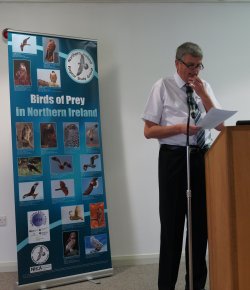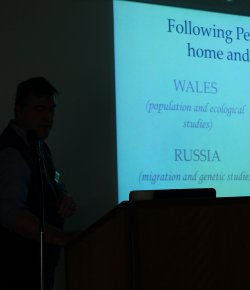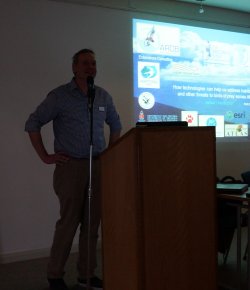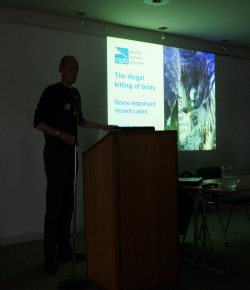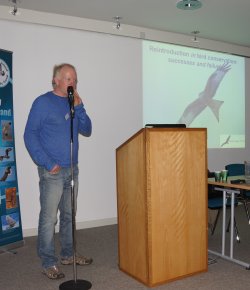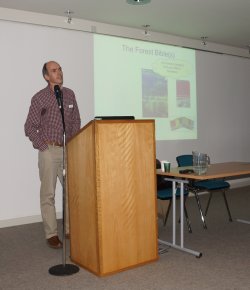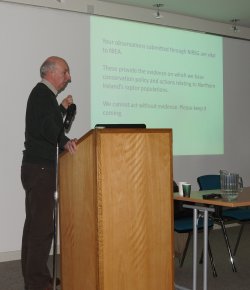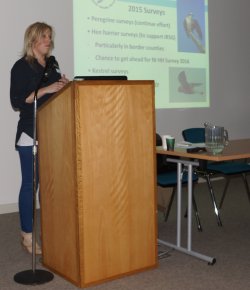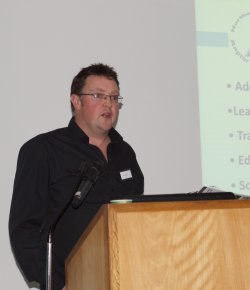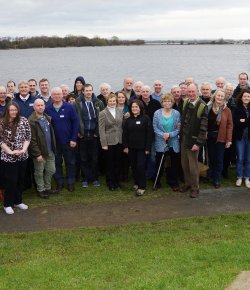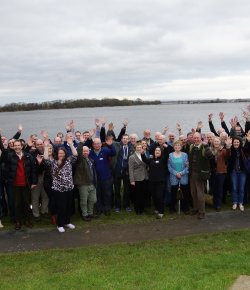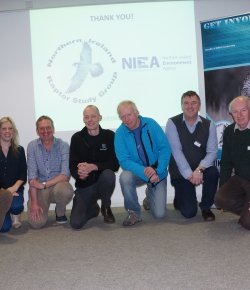Review of the NIRSG 2015 annual conference
Delegates gathered at the fabulous Lough Neagh Discovery Centre at Oxford Island National Nature Reserve in Co. Armagh for the NIRSG’s annual conference in March 2015, and were warmly welcomed by NIRSG Chairman, Jim Wells.
The first talk of the morning was from Dr Andrew Dixon (International Wildlife Consultants Ltd) on ‘Peregrines home and away: studies in Wales and Russia’. Andrew discussed some of his earlier research with the South Wales Peregrine Monitoring Group, assessing peregrine diet from pellet and prey analysis. He found that peregrines in south Wales seemed to specialise in racing pigeons (plenty of pigeon lofts there), whereas the diet of peregrines in central Wales (with fewer pigeon lofts) was much more diverse. He also discussed his research on historical and current peregrine populations in Wales, utilising historical egg collections from the pre-DDT era of 1950-1969. He concluded that the peregrine population in south Wales was stable, as was the population in the Brecon Beacons, but suggested that the central Wales population was in recent decline, largely due to fewer racing pigeons coming through from south Wales due to changed routes.
The second part of Andrew’s talk covered his more recent research on the conservation of peregrine populations in arctic Eurasia that may potentially be affected by Arabic falconry. He told us about his five year project which involves fitting GPS satellite transmitters to peregrines in locations such as Siberia and using the data to determine their migratory routes and wintering areas. He is also developing a genetic and stable isotope marker system from these northerly populations to help identify the origin of peregrines which may have been trapped in Arabia during the winter for falconry purposes.
The second person due to present a talk was Richard Francksen (PhD student, Newcastle University) on ‘Diet and foraging patterns of common buzzards on Langholm Moor: exploring impacts on red grouse’. Unfortunately Richard was unable to attend so Dr Eimear Rooney, another buzzard expert, stepped in and presented on Richard’s behalf. Part of Richard’s research was to assess whether buzzards on Langholm Moor, whose diet he had found to contain predominantly field voles, might switch to another prey species (notably the red grouse) in years when voles undergo a cyclical population decline. He assessed over 2,000 buzzard prey items from 13-16 buzzard nests between 2011 and 2013, which encompassed a whole vole cycle. His assessment was based on motion-triggered cameras and analysis of pellet and prey remains. An Index of Relative Importance was used to assess the importance of various prey groups to buzzard diet and it was found that the proportion of voles in the buzzards’ diet decreased in line with vole indices. When the vole population crashed, he found that grouse were less frequent in the buzzards’ diet and instead, the buzzards switched to eating more lagomorphs, moles, shrews and corvids; prey groups typically associated with moorland fringe and farmland habitats. This may suggest that when provisioning their chicks, buzzards at Langholm take red grouse only incidentally while hunting for voles within moorland habitats.
The third speaker of the day was Dr Rob Davies (Director, Habitat Info) whose presentation was on ‘How technologies can help us address habitat loss and other threats to birds of prey across Africa’. Rob has established a new project called the African Raptor Databank (ARDB) which is an innovative citizen science project aiming to ascertain the conservation status of raptors and their habitats across Africa. People on the ground can submit their raptor observations to the database, either via email or directly via a new app recently launched for Android. Project managers can then overlay the raptor data with habitat data and create a conservation atlas for African raptors, which will be crucial for guiding future conservation efforts for these birds. The project has five key objectives:
- To establish a secure and easy to use communal store for data and observations on African raptors across their distribution ranges;
- To use these observations to identify the exact habitat of each species and use the improving environmental datasets to assess the past, present and future conditions of that habitat and so improve our conservation assessments for each species;
- To use these observations to study seasonal and inter-annual movement patterns of raptors across Africa and help identify locations of risk to migrants;
- To use raptors to identify key habitat strongholds for their populations and by default populations of many other wildlife species in Africa both inside and outside protected areas
- To build a community of raptor enthusiasts and experts across Africa who can lobby for the preservation of those habitat strongholds and key migratory sites.
The project will be completed in two phases. The first phase involves building the database over a period of five years (2013-2018) and the second phase will be the production of the atlas. Rob launched the project in 2012 and already, by the end of February 2015, the database contains 103,226 records.
The final speaker of the morning was Bob Elliot (Head of Investigations, RSPB) who spoke on ‘The illegal killing of birds – some important recent cases’. Bob presented the by now very familiar figures showing the link between illegal raptor persecution and the game-shooting industry. The figures from one of his graphs were striking – the occupations and interests of all those convicted of raptor persecution since 1990: 113 had game-keeping interests, 17 unknown, 11 involved in taxidermy, 9 in farming, 8 with pigeon racing interests, 1 bird keeper and 1 pest controller. He then talked through some recent cases of note from England and Scotland, including the conviction of gamekeeper George Mutch from the Kildrummy Estate in Aberdeenshire, who had been caught on film trapping buzzards and goshawks and clubbing a goshawk to death. This was a significant case because it resulted in Mutch receiving a four month custodial sentence; the first gamekeeper ever to be sent to prison for killing raptors. Bob also mentioned the Allen Lambert case – a gamekeeper on the Stody Estate in Norfolk who was convicted of poisoning 11 raptors, including 10 buzzards and a sparrowhawk. Despite the extent of his crimes, Lambert escaped with a suspended sentence. Another recent landmark case was the conviction of landowner Ninian Johnston Stewart, who was the first person to be successfully prosecuted under new vicarious liability legislation in Scotland. His gamekeeper had previously been convicted of poisoning a buzzard on Johnston Stewart’s Glasserton & Physgill Estates and the landowner was not able to show he had used ‘due diligence’ to prevent the crime from happening. Johnston Stewart was fined a paltry £675, although he did later receive an agricultural subsidy penalty of nearly £66,000.
After a fine hot lunch and a chance to talk with colleagues and stretch our legs around the Lough Neagh, the afternoon presentations kicked off with a talk from Dr Allan Mee (Golden Eagle Trust) on ‘Reintroductions in bird conservation: successes and failures’. This was a fascinating review of the concept of reintroduction biology, including a useful summary of definitions and IUCN guidelines, and the role of research in reintroduction planning. Allan illustrated his talk with four case studies: California Condors in North America (a project on which Allan had worked from 2001-2006), Thick-billed parrots in Mexico, White-tailed Eagles in Ireland (Allan has directed this project since it began in 2006), and Spix Macaws in Brazil. He discussed the practical and political problems associated with each project and highlighted the economic and social benefits of reintroduction, in addition to the obvious benefits to biological conservation.
Next to speak was John Griffin (Forest Service) who gave a short talk on ‘The use of species records by forestry managers’. John began with an explanation of forest management and how things had improved over the years, with environmental sustainability now at the heart of all forestry management plans. He explained that 25% of the Forest Service estate includes specially designated sites such as Special Areas of Conservation (SAC), Special Protection Areas (SPA), Ramsar, Areas of Special Scientific Interest (ASSI) and National Nature Reserves (NNR). With over 80,000 hectares to manage, John appealed for information from NIRSG workers to help identify the location of rare and protected raptor species. It’s crucial to consider these species in forestry management plans such as harvesting operations and the timing of the tree felling, to minimise disturbance to breeding birds. Raptor records from the NIRSG are essential to the Forest Service as they don’t have the manpower to find all the birds on their own, so records from the NIRSG are of huge value to the forest manager. John emphasised the need for accurate records, and most importantly, timely records – the forestry manager needs the information ASAP rather than at the end of the breeding season. John ended his presentation with a discussion on the five-year forest reviews and he encouraged NIRSG members to join in on consultations as their expertise would be valuable.
The following speaker was Dr Neil McCulloch (Northern Ireland Environment Agency), whose talk was entitled ‘Raptors: protection and planning’. Neil’s talk focused on the importance of raptor data to the NIEA and encouragement to NIRSG members to submit their data. He explained that the data are essential to NIEA planning, particularly the designation of protected sites, condition assessment of designated sites, environmental impact assessments, and for identifying priority species for conservation. He gave some examples of the most frequent use of the data in planning consultations, including issues with wind farms (raptor disturbance, displacement, collision) and the designation of SPAs for species such as Hen Harrier, Peregrine and Merlin. The data that NIEA are most in need of are: nest locations, productivity, territory extent, foraging areas, changes in distribution and winter roost sites. He thanked the NIRSG for the data they have provided so far and looked forward to receiving more!
The final speakers of the day were Dr Eimear Rooney and Dr Marc Ruddock (NIRSG Management Committee) who provided updates on NIRSG activities over the past year, what is planned for this year, and a discussion on changes to NIRSG management and functional operational issue in the present and in the longer term.
The NIRSG would like to express considerable thanks to all of the speakers for such excellent talks and also to the Northern Ireland Environment Agency (Department of Environment) for their grant aid which provides financial support for the conference.

